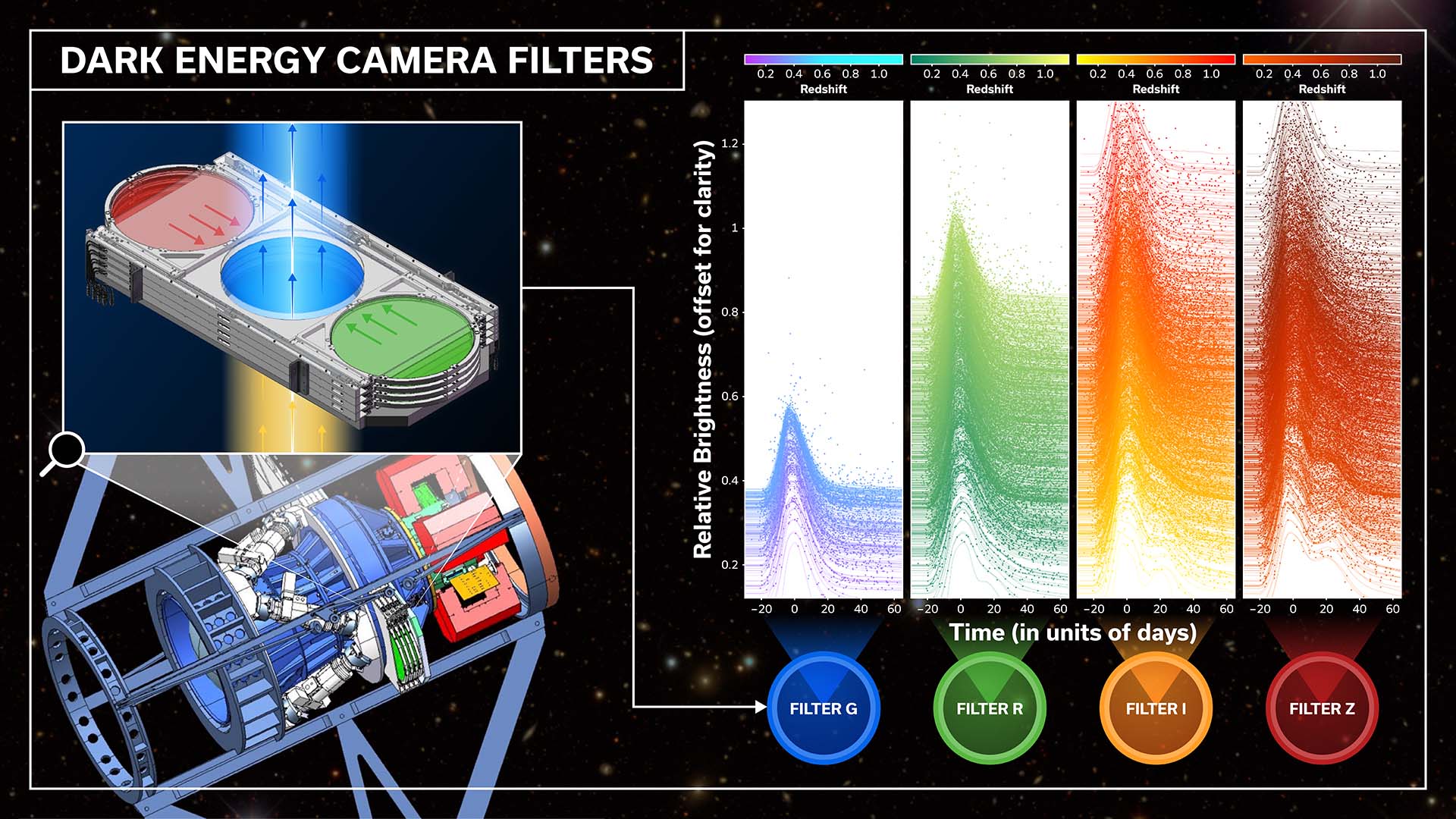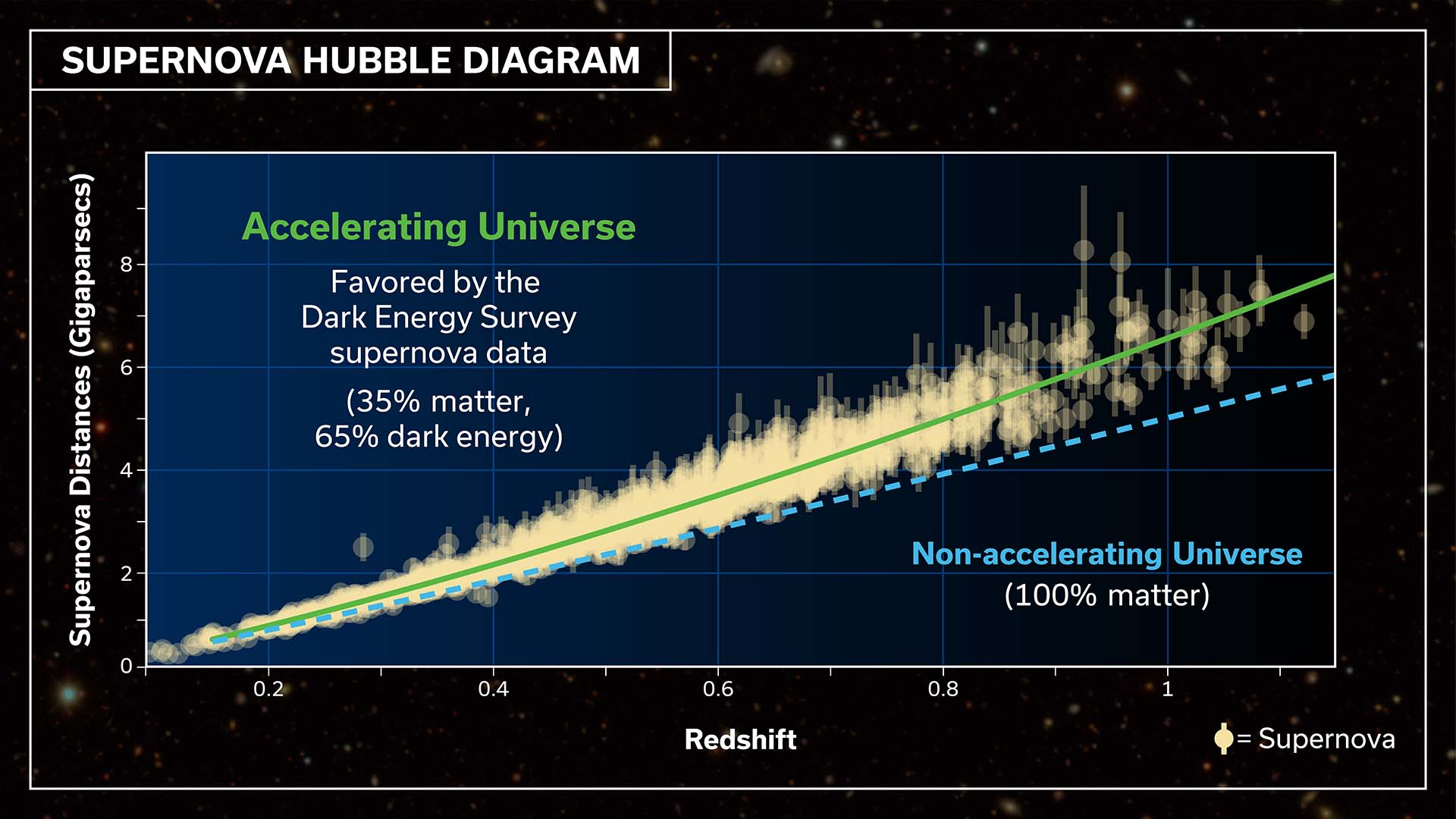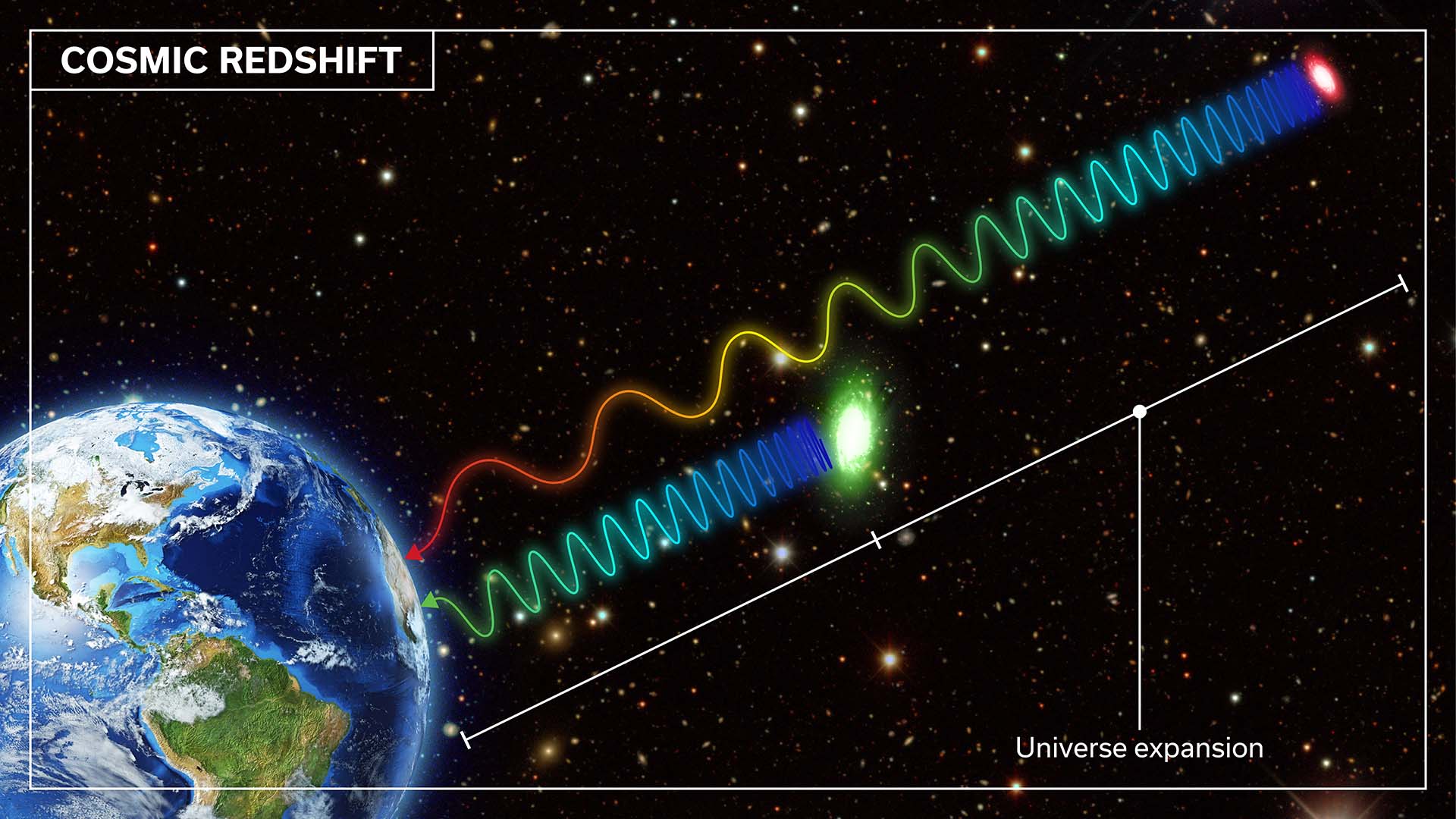Dark Energy Survey Results Offer Insights to Universe's Expansion
In the culmination of a decade's worth of effort, the DES collaboration of scientists analyzed an unprecedented sample of more than 1,500 supernovae classified using machine learning
By Madeleine O’Keefe
Media Inquiries- Interim Director of Communications, MCS
- 412-268-9982
- Media Relations Manager, Fermilab National Accelerator Laboratory
- 224-290-7803
In 1998, astrophysicists discovered that the universe is expanding at an accelerating rate, attributed to a mysterious entity called dark energy that makes up about 70% of our universe. While foreshadowed by earlier measurements, the discovery was somewhat of a surprise; at the time, astrophysicists agreed that the universe's expansion should be slowing down because of gravity.
This revolutionary discovery, which astrophysicists achieved with observations of specific kinds of exploding stars, called type Ia (read "type one-A") supernovae, was recognized with the Nobel Prize in Physics in 2011.
Now, 25 years after the initial discovery, the scientists working on the Dark Energy Survey have released the results of an unprecedented analysis using the same technique to further probe the mysteries of dark energy and the expansion of the universe. They placed the strongest constraints on the expansion of the universe ever obtained with the DES supernova survey.
In a presentation at the 243rd meeting of the American Astronomical Society on Jan. 8 and in a paper submitted to the Astrophysical Journal in January titled, "The Dark Energy Survey: Cosmology results with ~1500 new high-redshift type Ia supernovae using the full 5-year dataset," DES astrophysicists report results that are consistent with the now-standard cosmological model of a universe with an accelerated expansion. Yet, the findings are not definitive enough to rule out a possibly more complex model.
Researchers from the National Science Foundation's (NSF's) Artificial Intelligence (AI) Planning Institute for Data-Driven Discovery in Physics and Carnegie Mellon University's McWilliams Center for Cosmology were part of the multi-institution team, and brought Carnegie Mellon's expertise in weak gravitational lensing, artificial intelligence and data science to the DES analysis.

This diagram shows the filter system installed on the Dark Energy Camera used by DES to discover supernovae and monitor their brightness evolution. The method uses an unprecedented four filters: g (bluest filter), r, i, and z (reddest filter).
Taking a unique approach to analysis
The Dark Energy Survey is an international collaboration comprising more than 400 astrophysicists, astronomers and cosmologists from over 25 institutions led by members from the U.S. Department of Energy's Fermi National Accelerator Laboratory. DES mapped an area almost one-eighth the entire sky using the Dark Energy Camera, a 570-megapixel digital camera built by Fermilab and funded by the DOE Office of Science. It was mounted on the Víctor M. Blanco Telescope at the National Science Foundation's Cerro Tololo Inter-American Observatory, a Program of NSF's NOIRLab in 2012. DES scientists took data for 758 nights across six years.
To understand the nature of dark energy and measure the expansion rate of the universe, DES scientists perform analyses with four different techniques, including the supernova technique used in 1998.
This technique requires data from type Ia supernovae, which occur when an extremely dense dead star, known as a white dwarf, reaches a critical mass and explodes. Since the critical mass is nearly the same for all white dwarfs, all type Ia supernovae have approximately the same actual brightness and any remaining variations can be calibrated out. So, when astrophysicists compare the apparent brightnesses of two type Ia supernovae as seen from Earth, they can determine their relative distances from us.
Astrophysicists trace out the history of cosmic expansion with large samples of supernovae spanning a wide range of distances. For each supernova, they combine its distance with a measurement of its redshift — how quickly it is moving away from Earth due to the expansion of the universe. They can use that history to determine whether the dark energy density has remained constant or changed over time.
"As the universe expands, the matter density goes down," said DES director and spokesperson Rich Kron, who is a Fermilab and University of Chicago scientist. "But if the dark energy density is a constant, that means the total proportion of dark energy must be increasing as the volume increases."

The history of the universe's expansion can be traced by comparing recessional velocities (redshifts) with distances determined for each supernova. The DES result shows that the expansion has been accelerating with cosmic time, the signature of dark energy.
The culmination of a decade of effort
The standard cosmological model is ΛCDM, or Lambda Cold Dark Matter, a model based on the dark energy density being constant over cosmic time. It tells us how the universe evolves, using just a few features, such as the density of matter, type of matter and behavior of dark energy. The supernova method constrains two of these features very well: matter density and a quantity called w, which indicates whether the dark energy density is constant or not.
"This work is the culmination of years of effort from talented people spread across the world; it has been a real privilege to be part of DES," said Scott Dodelson, director of the NSF AI Institute who co-led the DES Science Committee.
According to the standard cosmological model, the density of dark energy in the universe is constant, which means it doesn't dilute as the universe expands. If this is true, the parameter represented by the letter w should equal -1.
When the DES collaboration internally unveiled their supernova results, it was a culmination of a decade's worth of effort and an emotional time for many of the astrophysicists involved. "I was shaking," said Tamara Davis, a professor at the University of Queensland in Australia and co-convener of DES's supernova working group. "It was definitely an exciting moment."
The results found w = -0.80 +/- 0.18 using supernovae alone. Combined with complementary data from the European Space Agency's Planck telescope, w reaches -1 within the error bars.
"w is tantalizingly not exactly on -1, but close enough that it's consistent with -1," said Davis. "A more complex model might be needed. Dark energy may indeed vary with time."
To come to a definitive conclusion, scientists will need more data. But DES won't be able to provide that; the survey stopped taking data in January 2019. The supernova team, led by many Ph.D. students and postdoctoral fellows, will soon have extracted all they can from the DES observations.
"More than 30 people have been involved in this analysis, and it is the culmination of almost 10 years of work," said Maria Vincenzi, a research fellow at Duke University who co-led the cosmological analysis of the DES supernova sample. "Some of us started working on this project when we were barely at the beginning of our Ph.D., and we are now starting faculty positions. So, the DES Collaboration contributed to the growth and professional development of an entire generation of cosmologists."
Andresa Rodrigues De Campos is a Ph.D. candidate in the Department of Physics and an analysis team lead for the DES Collaboration.
"I have been privileged to be part of this project that has gathered one of the largest cosmological data-sets to date," Campos said. "Working with DES data has been both a challenging and an immensely rewarding experience."

Redshift is the term used to describe the stretching of wavelengths of the light with the expansion of the universe; the greater the object’s distance, the greater the redshift. The detailed history of the expansion of the universe is determined with a precise relation between the distances to galaxies — or supernovae — and their redshifts.
Pioneering a new approach
This final DES supernova analysis made many improvements upon DES's first supernova result released in 2018 that used just 207 supernovae and three years of data.
For the 2018 analysis, DES scientists combined data about the spectrum of each supernova to determine their redshifts and to classify them as type Ia or not. They then used images taken with different filters to identify the flux at the peak of the light curve — a method called photometry. But spectra are hard to acquire, requiring lots of observing time on the largest telescopes, which will be impractical for future dark energy surveys like the Legacy Survey of Space and Time, LSST, to be conducted at the Vera C. Rubin Observatory, operated jointly by NSF's NOIRLab and DOE's SLAC National Accelerator Laboratory.
The new study pioneers a new approach to use photometry — with an unprecedented four filters — to find the supernovae, classify them and measure their light curves. Follow-up spectroscopy of the host galaxy with the Anglo-Australian Telescope provided precise redshifts for every supernova. The use of the additional filters also enabled data that is more precise than previous surveys and is a major advancement compared to the Nobel-winning supernovae samples, which only used one or two filters.
DES researchers used advanced machine-learning techniques to aid in supernova classification. Among the data from about two million distant observed galaxies, DES found several thousand supernovae. Scientists ultimately used 1,499 type Ia supernovae with high-quality data, making it the largest, deepest supernova sample from a single telescope ever compiled. In 1998, the Nobel-winning astronomers used just 52 supernovae to determine that the universe is expanding at an accelerating rate.
"It's a really massive scale-up from 25 years ago," said Davis.
Antonella Palmese, former co-chair for the DES Galaxy Evolution & Quasars Working Group, said that the experience has broadened knowledge on more than just dark energy.
"This sample represents a unique opportunity not only to learn about dark energy, but also to understand the physical processes that govern the observed correlations between the supernovae properties and the content of the galaxies that host them," she said.
There are minor drawbacks of the new photometric approach compared to spectroscopy: Since the supernovae do not have spectra, there is greater uncertainty in classification. However, the much larger sample size enabled by the photometric approach more than makes up for this.
The innovative techniques DES pioneered will shape and further drive future astrophysical analyses. Projects like Rubin's LSST and NASA's Nancy Grace Roman Space Telescope will pick up where DES left off. "We're pioneering these techniques that will be directly beneficial for the next generation of supernova surveys," said Kron.
"This new supernova result is exciting because this means we can really tie a bow on it and hand it out to the community and say, 'This is our best attempt at explaining how the universe is working,'" said Dillon Brout, an assistant professor at Boston University who co-led the cosmological analysis of the DES Supernova sample with Vincenzi. "These constraints will now be the gold standard in supernova cosmology for quite some time."
Even with more advanced dark energy experiments forthcoming, DES scientists emphasized the importance of having theoretical models to explain dark energy in addition to their experimental observations. "All of this is really unknown territory," said Kron. "We do not have a theory that puts dark energy into a framework that relates to other physics that we do understand. For the time being, we in DES are working to constrain how dark energy works in practice with the expectation that, later on, some theories can be falsified."
DES scientists continue to use the supernova results in more analyses by integrating them with results obtained with the other DES techniques. "Combining the DES supernova information with these other probes will even better inform our cosmological model," said Davis.
"Even if we measure dark energy infinitely precisely, it doesn't mean we know what it is," she said. "Dark energy is still out there to be discovered."
